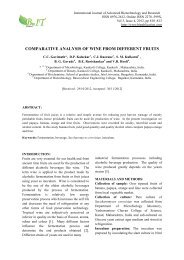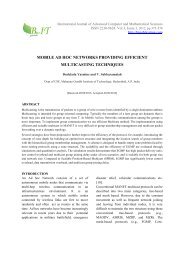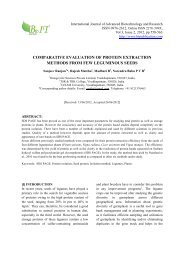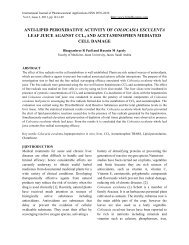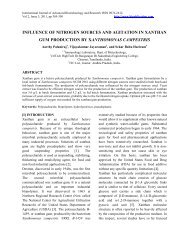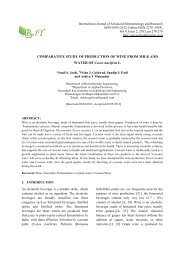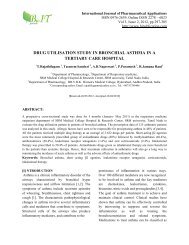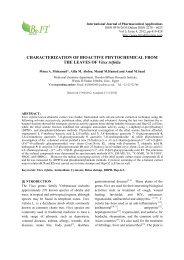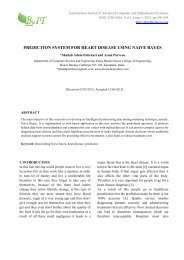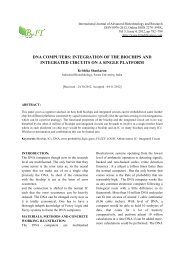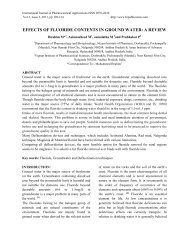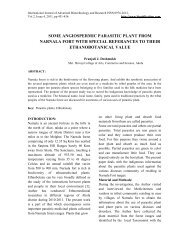antibacterial targets in pseudomonas aeruginosa - ResearchGate
antibacterial targets in pseudomonas aeruginosa - ResearchGate
antibacterial targets in pseudomonas aeruginosa - ResearchGate
Create successful ePaper yourself
Turn your PDF publications into a flip-book with our unique Google optimized e-Paper software.
ANTIBACTERIAL TARGETS IN PSEUDOMONAS AERUGINOSA<br />
dissem<strong>in</strong>ation and systemic disease. The<br />
importance of colonization and adherence is<br />
most evident <strong>in</strong> the context of respiratory tract<br />
<strong>in</strong>fection <strong>in</strong> patients with cystic fibrosis [13-15,<br />
31]. Production of extracellular proteases<br />
enhances the virulence of this pathogen by<br />
assist<strong>in</strong>g <strong>in</strong> bacterial adherence and <strong>in</strong>vasion [37,<br />
46, 55, 57].<br />
PSEUDOMONAS AERUGINOSA<br />
INFECTIONS<br />
P. aerug<strong>in</strong>osa causes life-threaten<strong>in</strong>g <strong>in</strong>fections<br />
<strong>in</strong> <strong>in</strong>dividuals with compromised immune<br />
systems, such as cancer patients undergo<strong>in</strong>g<br />
chemotherapy or patients with cystic fibrosis.<br />
Pseudomonas aerug<strong>in</strong>osa <strong>in</strong>fections can <strong>in</strong>volve<br />
any part of the body- respiratory tract, central<br />
nervous system, cardiovascular system, ear, eye,<br />
gastro<strong>in</strong>test<strong>in</strong>al system, ur<strong>in</strong>ary tract, sk<strong>in</strong> and<br />
bones and jo<strong>in</strong>ts [22, 27, 35].<br />
In plants, P. aerug<strong>in</strong>osa <strong>in</strong>duces symptoms of<br />
soft rot with Arabidopsis thaliana. It is a<br />
powerful pathogen with Arabidopsis.<br />
Pathogenesis <strong>in</strong> Arabidopsis <strong>in</strong>volves the<br />
follow<strong>in</strong>g steps: attachment to the leaf surface,<br />
congregation of bacteria at and <strong>in</strong>vasion through<br />
stomata or wounds, colonization of <strong>in</strong>tercellular<br />
spaces, and concomitant disruption of plant cell<br />
wall and membrane structures, basipetal<br />
movement along the vascular parenchyma, and<br />
maceration and rott<strong>in</strong>g of the petiole and central<br />
bud [47].<br />
Given the critical importance of Pseudomonas<br />
aerug<strong>in</strong>osa as an opportunistic pathogen, it is<br />
necessary to consider novel <strong>targets</strong> for<br />
therapeutic development. This is especially true<br />
as this bacterium is resistant to many<br />
antimicrobials [33, 48]. The resistance is<br />
ma<strong>in</strong>ly due to the low permeability of the<br />
bacterial cellular envelope [31]. Thus, there is a<br />
real need for new drugs and approaches to<br />
control the myriad of diseases caused by this<br />
pathogen [39].<br />
TARGETS FOR DRUG DISCOVERY [36]<br />
Exotox<strong>in</strong> A<br />
Exotox<strong>in</strong> A is one of the major virulence factor<br />
<strong>in</strong> P. aerug<strong>in</strong>osa <strong>in</strong>fections such as septicemia,<br />
corneal <strong>in</strong>fections and lung <strong>in</strong>fections [8, 50]. P.<br />
aerug<strong>in</strong>osa exotox<strong>in</strong> A enhances the<br />
pathogenicity of this bacterium via <strong>in</strong>hibit<strong>in</strong>g the<br />
production of pro-<strong>in</strong>flammatory cytok<strong>in</strong>es. This<br />
<strong>in</strong>dicates that Exotox<strong>in</strong> A can be a potential<br />
target for the development of a novel antibiotic<br />
aga<strong>in</strong>st P. aerug<strong>in</strong>osa.<br />
Exoenzyme S<br />
Exoenzyme S (ExoS) is a 49-kDa ADPribosyltransferase<br />
which plays an important role<br />
<strong>in</strong> P. aerug<strong>in</strong>osa pathogenesis [23]. Virtually all<br />
pneumonia and cystic fibrosis (CF) pulmonary<br />
Pseudomonas isolates produces P. aerug<strong>in</strong>osa<br />
virulence factor exoenzyme S [17]. Increased<br />
levels of ExoS correlate with <strong>in</strong>creased<br />
pulmonary damage <strong>in</strong> animal models and CF<br />
patients [41-44]. Target<strong>in</strong>g ExoS may<br />
effectively reduce the P. aerug<strong>in</strong>osa <strong>in</strong>fections.<br />
Flagell<strong>in</strong><br />
Flagella P. aerug<strong>in</strong>osa conta<strong>in</strong> the prote<strong>in</strong><br />
flagell<strong>in</strong> as a major structural component.<br />
Flagell<strong>in</strong> b<strong>in</strong>ds to the host cell membrane<br />
glycolipid. B<strong>in</strong>d<strong>in</strong>g to the glycolipid may change<br />
the transport properties of epithelial cells [19,<br />
38]. Also the flagellum of Pseudomonas<br />
aerug<strong>in</strong>osa is essential for resistance to clearance<br />
by the surfactant prote<strong>in</strong> A which is an<br />
important lung <strong>in</strong>nate immune prote<strong>in</strong> that kills<br />
microbial pathogens by opsonization and<br />
membrane permeabilization [43-44, 61].<br />
Flagell<strong>in</strong> can be a successful drug target.<br />
Pyocyan<strong>in</strong><br />
Pyocyan<strong>in</strong> is the blue phenaz<strong>in</strong>e pigment that is<br />
produced by P. aerug<strong>in</strong>osa. Pyocyan<strong>in</strong> slower<br />
the ciliary beat and disrupts the <strong>in</strong>tegrity of the<br />
epithelium <strong>in</strong> vitro. Also it results <strong>in</strong> slow<strong>in</strong>g of<br />
mucociliary transport <strong>in</strong> gu<strong>in</strong>ea pig trachea <strong>in</strong><br />
vivo. Pyocyan<strong>in</strong>-<strong>in</strong>duced ciliary slow<strong>in</strong>g is<br />
associated with a decrease <strong>in</strong> both <strong>in</strong>tracellular<br />
cAMP and ATP. Studies revealed that the agents<br />
that raise <strong>in</strong>tracellular cAMP levels <strong>in</strong>hibit the<br />
effect of pyocyan<strong>in</strong> on epithelium. This reflects<br />
that <strong>in</strong>hibition of pyocyan<strong>in</strong> may prevent the<br />
pathogenesis of p. aerug<strong>in</strong>osa.<br />
Protease IV<br />
Protease IV, is a 26 kDa ser<strong>in</strong>e endoprotease,<br />
secreted by most P. aerug<strong>in</strong>osa stra<strong>in</strong>s caus<strong>in</strong>g<br />
microbial keratitis. In association with other<br />
proteases protease IV has a major role <strong>in</strong> corneal<br />
virulence. The virulence of protease IV <strong>in</strong> ocular<br />
Shanooba M. Palamthodi, et al. 160



